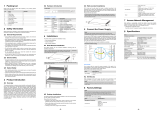
iv
LPU ordering guide ·············································································································································120
Power module·······························································································································································120
Power module overview ·····································································································································120
Power module ordering guide ···························································································································121
Fan tray ·········································································································································································122
Fan tray overview················································································································································122
Fan tray ordering guide······································································································································122
Air filter ·········································································································································································123
Air filter overview ················································································································································123
Air filter ordering guide······································································································································123
PoE DIMM·····································································································································································123
PoE DIMM overview············································································································································123
PoE DIMM ordering guide ·································································································································123
CF card ·········································································································································································124
CF card overview ················································································································································124
CF card ordering guide······································································································································124
Transceiver modules ····················································································································································124
Transceiver module overview·····························································································································124
Transceiver module ordering guide···················································································································127
AC power cable···························································································································································127
AC power cable overview ·································································································································127
AC power cable ordering guide ·······················································································································128
Appendix C LEDs··················································································································································· 134
SRPU LEDs·····································································································································································135
LPU LEDs········································································································································································139
Power module LEDs······················································································································································141
Appendix D Cables ··············································································································································· 149
Ethernet twisted pair cable··········································································································································149
RJ-45 connector ···················································································································································149
Cable pinouts·······················································································································································149
Cable type····························································································································································150
Pin assignments····················································································································································151
Making an Ethernet twisted pair cable·············································································································152
Optical fiber ·································································································································································153
Overview······························································································································································153
Precautions···························································································································································154
SFP+ cable····································································································································································155
Appendix E Cabling recommendations ··············································································································· 156
General cabling requirements ····································································································································156
Correct use of labels····················································································································································156
Cable management requirements ······························································································································156
Compliance and safety manual····························································································································· 160
Regulatory compliance statement·······························································································································160
European Community CE Certification DoC ····································································································160
Regulatory Compliance Information···························································································································160
Regulatory compliance standards ·····················································································································160
European Directives compliance ·······················································································································161
USA regulatory compliance ·······························································································································161
Canada regulatory compliance·························································································································161
Japan regulatory compliance·····························································································································161
CISPR 22 compliance ·········································································································································162
Safety Information Sicherheitsinformationen安全信息 ·····························································································162




















